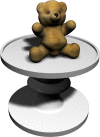MnemoCity Task: Assessment of Childrens Spatial Memory Using Stereoscopy and Virtual Environments
- PMID: 27579715
- PMCID: PMC5007040
- DOI: 10.1371/journal.pone.0161858
MnemoCity Task: Assessment of Childrens Spatial Memory Using Stereoscopy and Virtual Environments
Abstract
This paper presents the MnemoCity task, which is a 3D application that introduces the user into a totally 3D virtual environment to evaluate spatial short-term memory. A study has been carried out to validate the MnemoCity task for the assessment of spatial short-term memory in children, by comparing the children's performance in the developed task with current approaches. A total of 160 children participated in the study. The task incorporates two types of interaction: one based on standard interaction and another one based on natural interaction involving physical movement by the user. There were no statistically significant differences in the results of the task using the two types of interaction. Furthermore, statistically significant differences were not found in relation to gender. The correlations between scores were obtained using the MnemoCity task and a traditional procedure for assessing spatial short-term memory. Those results revealed that the type of interaction used did not affect the performance of children in the MnemoCity task.
Conflict of interest statement
The authors have declared that no competing interests exist.
Figures













Similar articles
-
Augmented reality for the assessment of children's spatial memory in real settings.PLoS One. 2014 Dec 1;9(12):e113751. doi: 10.1371/journal.pone.0113751. eCollection 2014. PLoS One. 2014. PMID: 25438146 Free PMC article.
-
Developmental gender differences in children in a virtual spatial memory task.Neuropsychology. 2014 Jul;28(4):485-95. doi: 10.1037/neu0000054. Epub 2014 Mar 3. Neuropsychology. 2014. PMID: 24588700
-
Virtual reality assessment of walking and non-walking space in men and women with virtual reality-based tasks.PLoS One. 2018 Oct 2;13(10):e0204995. doi: 10.1371/journal.pone.0204995. eCollection 2018. PLoS One. 2018. PMID: 30278083 Free PMC article.
-
Developmental normative data for the Baron-Hopkins Board test of spatial location memory.Child Neuropsychol. 2015;21(6):732-50. doi: 10.1080/09297049.2014.957264. Epub 2014 Sep 29. Child Neuropsychol. 2015. PMID: 25265314
-
Learning Mathematics in a Visuospatial Format: A Randomized, Controlled Trial of Mental Abacus Instruction.Child Dev. 2016 Jul;87(4):1146-58. doi: 10.1111/cdev.12515. Epub 2016 Apr 8. Child Dev. 2016. PMID: 27062391 Review.
Cited by
-
SLAM-based augmented reality for the assessment of short-term spatial memory. A comparative study of visual versus tactile stimuli.PLoS One. 2021 Feb 4;16(2):e0245976. doi: 10.1371/journal.pone.0245976. eCollection 2021. PLoS One. 2021. PMID: 33539369 Free PMC article.
-
A Virtual Object-Location Task for Children: Gender and Videogame Experience Influence Navigation; Age Impacts Memory and Completion Time.Front Psychol. 2018 Apr 4;9:451. doi: 10.3389/fpsyg.2018.00451. eCollection 2018. Front Psychol. 2018. PMID: 29674988 Free PMC article.
-
Egocentric and allocentric spatial memory in typically developed children: Is spatial memory associated with visuospatial skills, behavior, and cortisol?Brain Behav. 2020 May;10(5):e01532. doi: 10.1002/brb3.1532. Epub 2020 Mar 14. Brain Behav. 2020. PMID: 32170996 Free PMC article.
-
Sex Differences and the Role of Gaming Experience in Spatial Cognition Performance in Primary School Children: An Exploratory Study.Brain Sci. 2021 Jul 1;11(7):886. doi: 10.3390/brainsci11070886. Brain Sci. 2021. PMID: 34356121 Free PMC article.
-
Memory for Object Location in Augmented Reality: The Role of Gender and the Relationship Among Spatial and Anxiety Outcomes.Front Hum Neurosci. 2019 Mar 28;13:113. doi: 10.3389/fnhum.2019.00113. eCollection 2019. Front Hum Neurosci. 2019. PMID: 31001098 Free PMC article.
References
-
- Martin-SanJose J-F, Juan M-C, Mollá R, Vivó R. Advanced displays and natural user interfaces to support learning. Interact Learn Environ. 2015; 1–18. 10.1080/10494820.2015.1090455 - DOI
-
- Juan MC, Calatrava J. An Augmented Reality System for the Treatment of Phobia to Small Animals Viewed Via an Optical See-Through HMD. Comparison with a similar system viewed via a video see-through HMD. Int J Hum Comput Interact. 2011;27: 436–449.
-
- Juan MC, Baños R, Botella C, Pérez D, Alcaniz M, Monserrat C. An Augmented Reality System for the Treatment of Acrophobia: The Sense of Presence Using Immersive Photography. Presence Teleoperators Virtual Environ. The MIT Press; 2006;15: 393–402. 10.1162/pres.15.4.393 - DOI
Publication types
MeSH terms
LinkOut - more resources
Full Text Sources
Other Literature Sources

